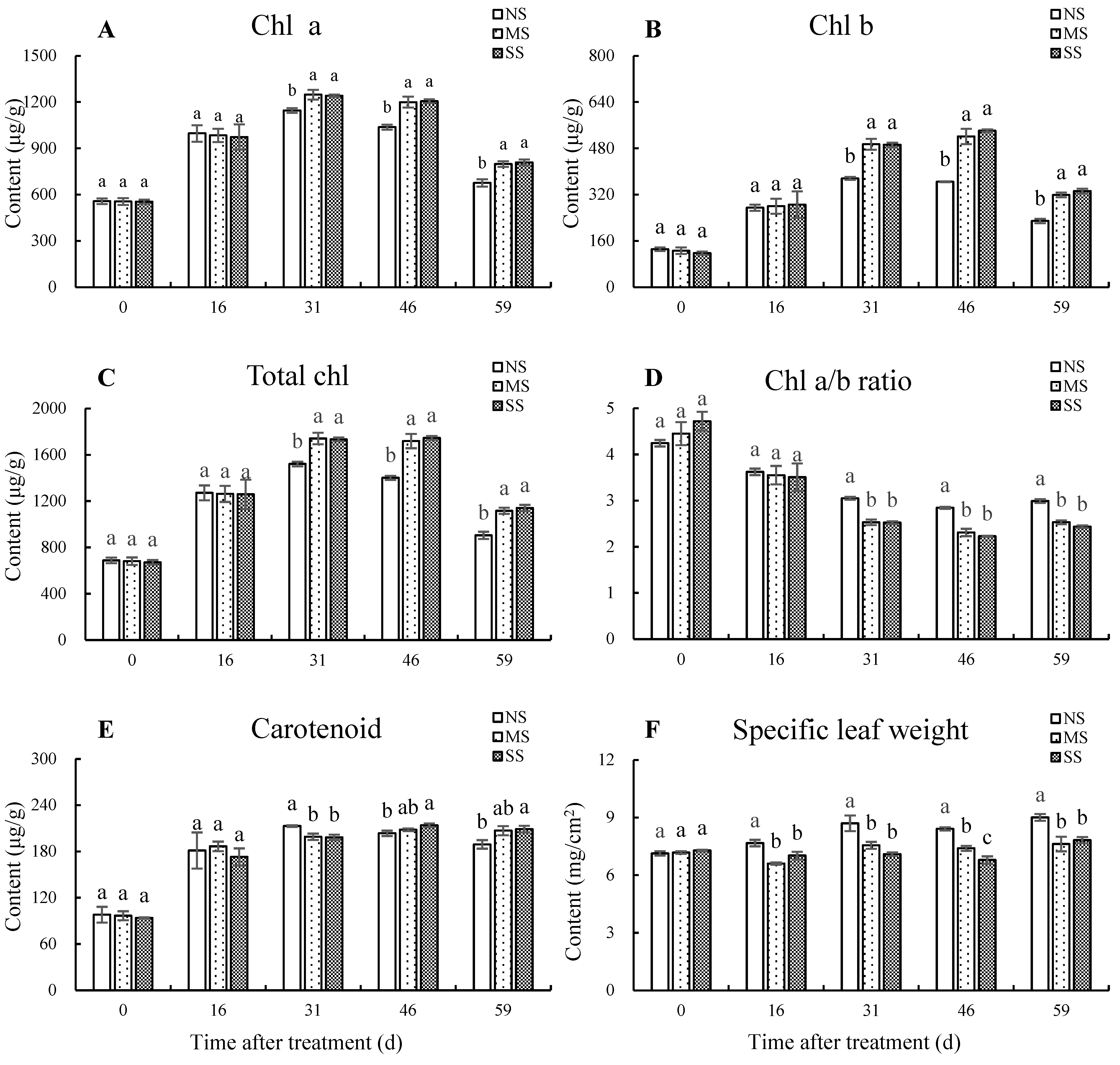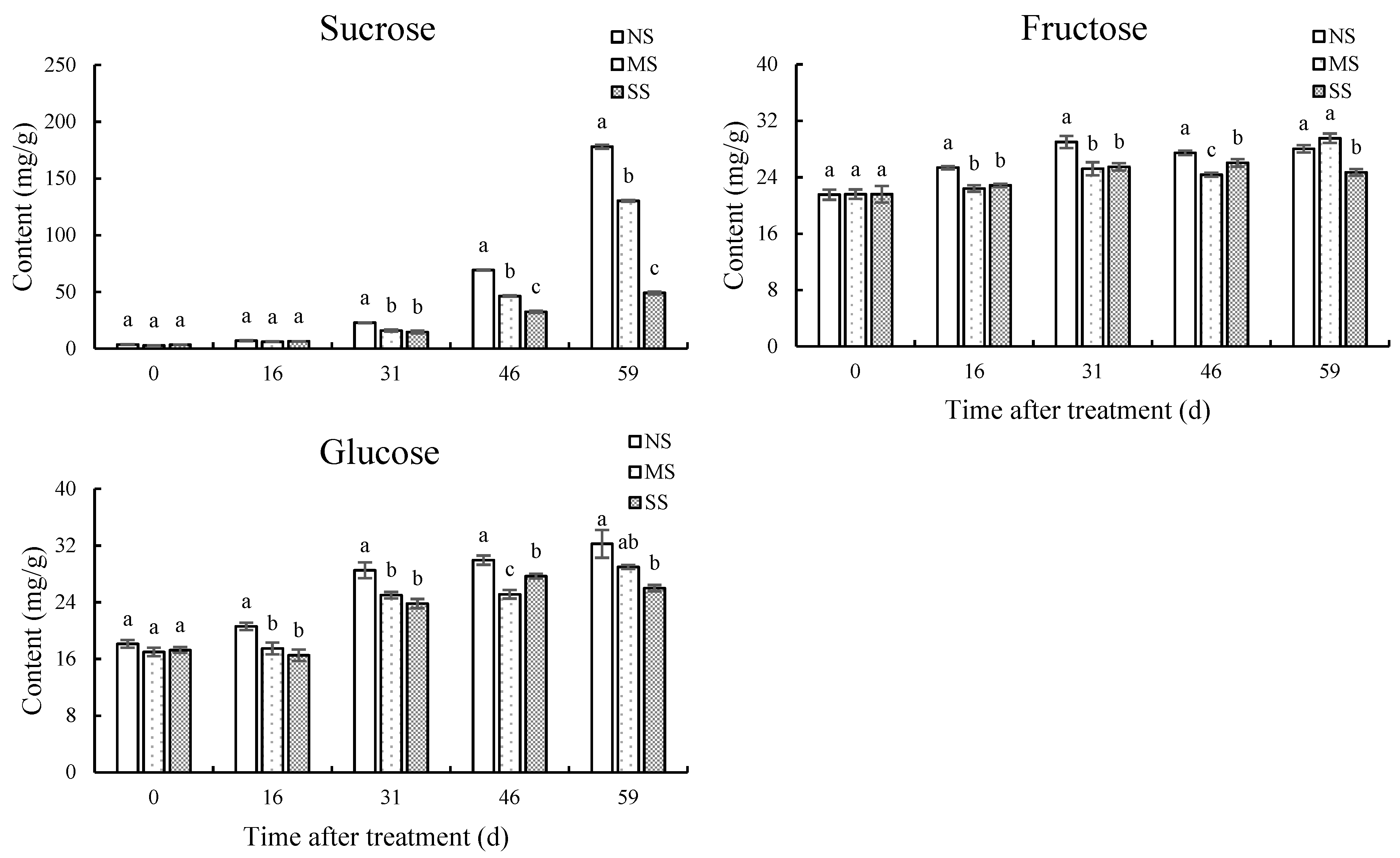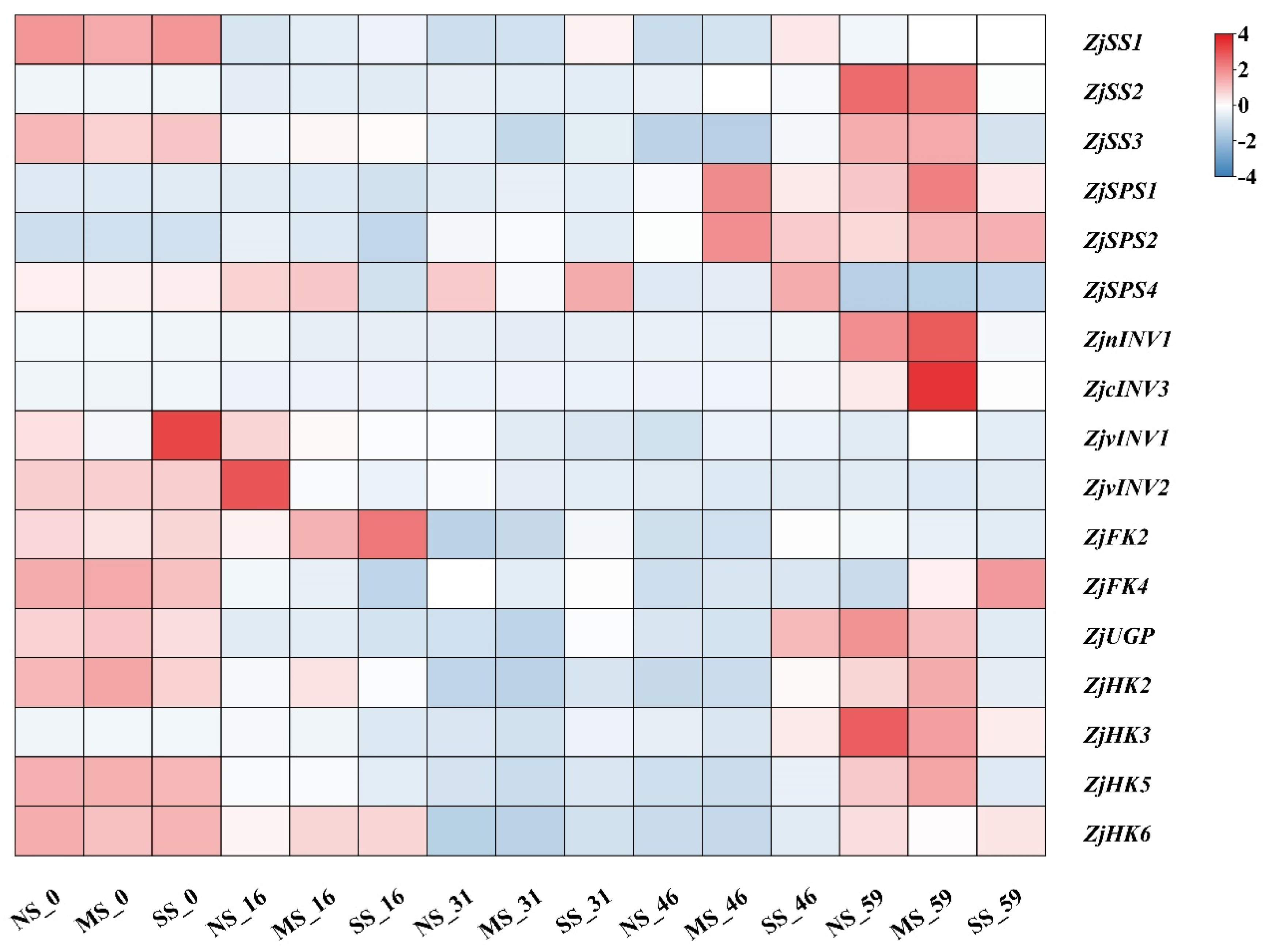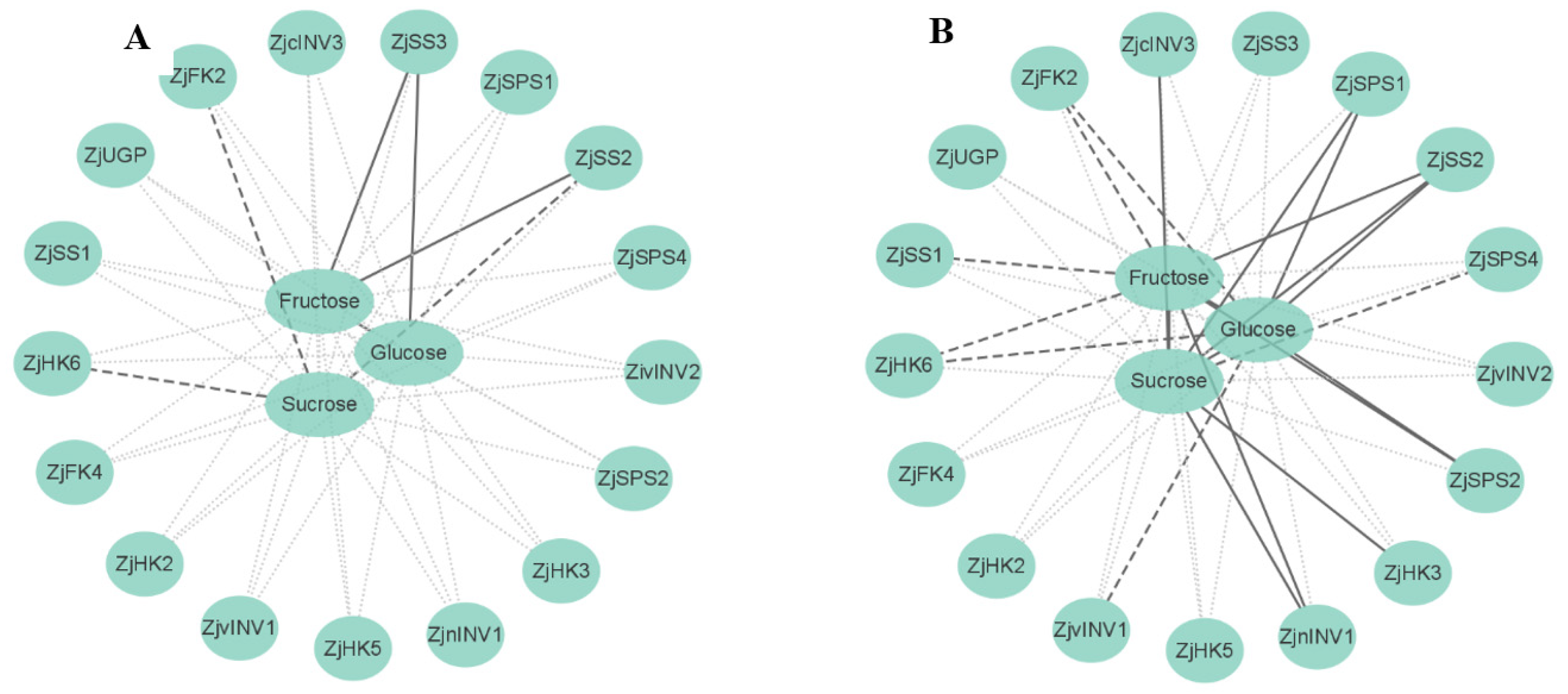Shading Inhibits Sugar Accumulation in Leaf and Fruit of Jujube (Ziziphus jujuba Mill.)
Abstract
:1. Introduction
2. Materials and Methods
2.1. Materials
2.2. Determination of Photosynthetic Pigments and Specific Leaf Weight
2.3. Determination of Content and Composition of Soluble Sugar
2.4. RNA Extraction, cDNA Synthesis, and Genes Expression Analysis
2.5. Statistical Analysis
3. Results
3.1. Dynamic Changes of Photosynthetic Pigments and Specific Leaf Weight
3.2. Dynamic Changes of Soluble Sugar Contents in Leaves
3.3. Dynamic Changes of Soluble Sugar Contents in Fruits
3.4. Expression of Genes Involved in Sugar Metabolism in Leaves
3.5. Expression of Genes Involved in Sugar Metabolism in Fruits
3.6. Correlation Analysis of Metabolite Contents and Gene Expression
4. Discussion
4.1. Shading Increased Photosynthetic Pigment Contents of Leaves but Decreased Specific Leaf Weight
4.2. Shading Inhibited Sugar Accumulation in Leaves
4.3. Shading Inhibited Sugar Accumulation in Fruits
4.4. Shading May Affected Sugar Transport from Leaf to Fruit
5. Conclusions
Supplementary Materials
Author Contributions
Funding
Institutional Review Board Statement
Informed Consent Statement
Conflicts of Interest
References
- Kishore, K.; Rupa, T.R.; Samant, D. Influence of shade intensity on growth, biomass allocation, yield and quality of pineapple in mango-based intercropping system. Sci. Hortic. 2021, 278, 109869. [Google Scholar] [CrossRef]
- Choi, H.G. Correlation among phenotypic parameters related to the growth and photosynthesis of strawberry (Fragaria × ananassa Duch.) grown under various light intensity conditions. Front. Plant Sci. 2021, 12, 647585. [Google Scholar] [CrossRef] [PubMed]
- Mditshwa, A.; Magwaza, L.S.; Tesfay, S.Z. Shade netting on subtropical fruit: Effect on environmental conditions, tree physiology and fruit quality. Sci. Hortic. 2019, 256, 108556. [Google Scholar] [CrossRef]
- Palmer, J.; Diack, R.; Johnston, J.; Boldingh, H. Manipulation of fruit dry matter accumulation and fruit size in ‘Scifresh’ apple through alteration of the carbon supply, and its relationship with apoplastic sugar composition. J. Hortic. Sci. Bitechnol. 2013, 88, 483–489. [Google Scholar] [CrossRef]
- Jing, C.J.; Feng, D.P.; Zhao, Z.Y.; Wu, X.H.; Chen, X.F. Effect of environmental factors on skin pigmentation and taste in three apple cultivars. Acta Physiol. Plant. 2020, 42, 69. [Google Scholar] [CrossRef]
- Li, M.J.; Ma, F.W.; Liu, J.; Li, J. Shading the whole vines during young fruit development decreases ascorbate accumulation in kiwi. Physiol. Plant. 2010, 140, 225–237. [Google Scholar] [CrossRef]
- Peavey, M.; Goodwin, I.; Mcclymont, L.; Chandra, S. Effect of shading on red colour and fruit quality in blush pears “Anp-0118” and “Anp-0131”. Plant 2020, 9, 206. [Google Scholar] [CrossRef] [Green Version]
- Li, C.Q.; Wang, Y.; Huang, X.M.; Li, J.; Wang, H.; Li, J.G. De novo assembly and characterization of fruit transcriptome in Litchi chinensis Sonn and analysis of differentially regulated genes in fruit in response to shading. BMC Genom. 2013, 14, 552. [Google Scholar] [CrossRef] [Green Version]
- Zhu, H.; Dardick, C.D.; Beers, E.; Callanhan, A.M.; Xia, R.; Yuan, R.C. Transcriptomics of shading-induced and NAA-induced abscission in apple (Malus domestica) reveals a shared pathway involving reduced photosynthesis, alterations in carbohydrate transport and signaling and hormone crosstalk. BMC Plant Biol. 2011, 11, 138. [Google Scholar] [CrossRef] [Green Version]
- Jutamanee, K.; Onnom, S. Improving photosynthetic performance and some fruit quality traits in mango trees by shading. Photosynthetica 2016, 54, 542–550. [Google Scholar] [CrossRef]
- Abeysinghe, S.K.; Greer, D.H.; Rogiers, S.Y. The effect of light intensity and temperature on berry growth and sugar accumulation in Vitis vinifera ‘Shiraz’ under vineyard conditions. Vitis 2019, 58, 7–16. [Google Scholar]
- Milenkovic, L.; Mastilovic, J.; Kevresan, Z.; Bajic, A.; Gledic, A.; Stanojevic, L.; Cvetkovic, D.; Sunic, L.; Ilic, Z.S. Effect of shading and grafting on yield and quality of tomato. J. Sci. Food Agric. 2019, 100, 623–633. [Google Scholar] [CrossRef] [PubMed]
- Li, X.B.; Li, C.N.; Sun, J.; Jackson, A. Dynamic changes of enzymes involved in sugar and organic acid level modification during blueberry fruit maturation. Food Chem. 2020, 309, 125617. [Google Scholar] [CrossRef]
- Durán-Soria, S.; Pott, D.M.; Osorio, S.; Vallarino, J.G. Sugar signaling during fruit ripening. Front. Plant Sci. 2020, 11, 564917. [Google Scholar] [CrossRef]
- Xu, Q.Y.; Liesche, J. Sugar export from Arabidopsis leaves actors and regulatory strategies. J. Exp. Bot. 2021, 72, 5275–5284. [Google Scholar] [CrossRef] [PubMed]
- Manja, K.; Aoun, M. The use of nets for tree fruit crops and their impact on the production: A review. Sci. Hortic. 2019, 246, 110–122. [Google Scholar] [CrossRef]
- Abreu, A.C.; Marín, P.; Aguilera-Sáez, L.M.; Tristán, A.I.; Peña, A.; Oliveira, I.; Simões, M.; Valera, D.; Fernández, I. Effect of a shading mesh on the metabolic, nutritional, and defense profiles of harvested greenhouse-grown organic tomato fruits and leaves revealed by NMR metabolomics. J. Agric. Food Chem. 2019, 67, 12972–12985. [Google Scholar] [CrossRef]
- Choi, H.G.; Moon, B.Y.; Kang, N.J.; Kwon, J.K.; Bekhzod, K.; Park, K.S.; Lee, S.Y. Yield loss and quality degradation of strawberry fruits cultivated under the deficient insolation conditions by shading. Hortic. Environ. Biotechnol. 2014, 55, 263–270. [Google Scholar] [CrossRef]
- Meena, V.S.; Kashyap, P.; Nangare, D.D.; Singh, J. Effect of coloured shade nets on yield and quality of pomegranate (Punica granatum) cv. Mridula in semi-arid region of Punjab. Indian J. Agric. Sci. 2016, 86, 500–505. [Google Scholar]
- Mupambi, G.; Anthony, B.M.; Layne, D.R.; Musacchi, S.; Serra, S.; Schmidt, T.; Kalcsits, L.A. The influence of protective netting on tree physiology and fruit quality of apple: A review. Sci. Hortic. 2018, 236, 60–72. [Google Scholar] [CrossRef]
- Solomakhin, A.; Blanke, M.M. Can coloured hailnets improve taste (sugar, sugar: Acid ratio), consumer appeal (colouration) and nutritional value (anthocyanin, vitamin C) of apple fruit? LWT-Food Sci. Technol. 2010, 43, 1277–1284. [Google Scholar] [CrossRef]
- Liu, M.J.; Wang, J.; Wang, L.L.; Liu, P.; Zhao, J.; Zhao, Z.H.; Yao, S.R.; Stănică, F.; Liu, Z.G.; Wang, L.X.; et al. The historical and current research progress on jujube–a superfruit for the future. Hortic. Res. 2020, 7, 119. [Google Scholar] [CrossRef] [PubMed]
- Ma, Q.H.; Wang, G.X.; Liang, L.S. Development and characterization of SSR markers in Chinese jujube (Ziziphus jujuba Mill.) and its related species. Sci. Hortic. 2011, 129, 597–602. [Google Scholar] [CrossRef]
- Jiang, W.Q.; Li, N.; Zhang, D.; Meinhardt, L.; Cao, B.; Li, Y.J.; Song, L.H. Elevated temperature and drought stress significantly affect fruit quality and activity of anthocyanin-related enzymes in jujube (Ziziphus jujuba Mill. cv. ‘Lingwuchangzao’). PLoS ONE 2020, 15, e0241491. [Google Scholar] [CrossRef]
- Ren, S.; Wangy, Y.; Tang, Y.; Zhou, Q.; Deng, Q.X. Effect of shade treatment on active oxygen metabolism and fruit quality of Zizyphus jujuba fruit. Acta Agric. Boreali-Occident. Sin. 2020, 29, 709–717. [Google Scholar]
- Wu, X.Y.; Khan, R.; Gao, H.J.; Liu, H.B.; Zhang, J.; Ma, X.H. Low light alters the photosynthesis process in cigar tobacco via modulation of the chlorophyll content, chlorophyll fluorescence, and gene expression. Agriculture 2021, 11, 755. [Google Scholar] [CrossRef]
- Gao, Q.H.; Wu, C.S.; Yu, J.G.; Wang, M.; Ma, Y.J.; Li, C.L. Textural characteristic, antioxidant activity, sugar, organic acid, and phenolic profiles of 10 promising jujube (Ziziphus jujuba Mill.) selections. J. Food Sci. 2012, 77, 1218–1225. [Google Scholar] [CrossRef]
- Atanasova, L.; Stefanov, D.; Yordanov, I.; Kornova, K.; Kavardzikov, L. Comparative characteristics of growth and photosynthesis of sun and shade leaves from normal and pendulum walnut (Juglans regia L.) trees. Photosynthetica 2003, 41, 289–292. [Google Scholar] [CrossRef]
- Sekhar, S.; Panda, D.; Kumar, J.; Biswal, M.; Baig, M.J.; Kumar, A.; Umakanta, N.; Sangamitra, S.; Pradhan, S.K.; Shaw, B.P.; et al. Comparative transcriptome profiling of low light tolerant and sensitive rice varieties induced by low light stress at active tillering stage. Sci. Rep. 2019, 9, 5753. [Google Scholar] [CrossRef]
- Wang, M.; Jiang, W.J.; Yu, H.J. Effects of exogenous epibrassinolide on photosynthetic characteristics in tomato (Lycopersicon esculentum Mill.) seedlings under weak light stress. J. Agric. Food Chem. 2010, 58, 3642–3645. [Google Scholar] [CrossRef]
- Yu, H.J.; Zhao, W.C.; Wang, M.; Yang, X.Y.; Jiang, W.J. The exogenous application of spermidine alleviates photosynthetic inhibition and membrane lipid peroxidation under low-light stress in tomato (Lycopersicon esculentum Mill.) seedlings. Plant Growth Regul. 2015, 78, 413–420. [Google Scholar] [CrossRef]
- Qiu, T.; Wu, Y.Y.; Shen, Z.L.; Wu, Y.Y.; Lu, D.; He, J.W. Effects of shading on leaf physiology and morphology in the ‘Yinhong’ grape plants. Rev. Bras. De Frutic. 2018, 40, 37. [Google Scholar]
- Wolske, E.T.; Branham, B.E. Growth and productivity of ‘consort’ black currant grown under varying levels of artificial shade. Hortscience 2021, 56, 3–7. [Google Scholar] [CrossRef]
- Wu, H.Y.; Tang, H.K.; Liu, L.A.; Shi, L.; Zhang, W.F.; Jiang, C.D. Local weak light induces the improvement of photosynthesis in adjacent illuminated leaves in maize seedlings. Physiol. Plant. 2020, 171, 125–136. [Google Scholar] [CrossRef] [PubMed]
- Kozuka, T.; Horiguchi, G.; Kim, G.T.; Ohgishi, M.; Sakai, T.; Tsukaya, A.H. The different growth responses of the Arabidopsis thaliana leaf blade and the petiole during shade avoidance are regulated by photoreceptors and sugar. Plant Cell Physiol. 2005, 46, 213–223. [Google Scholar] [CrossRef] [Green Version]
- Jian, Y.; Wu, G.; Zhou, D.; Hu, Z.; Quan, Z.; Zhou, B. Effects of shading on carbohydrates of Syzygium samarangense. Not. Bot. Horti Agrobot. Cluj-Napoca 2019, 47, 1252–1257. [Google Scholar] [CrossRef] [Green Version]
- Wang, X.Q.; Huang, W.D.; Zhan, J.C. Effect of low light on the activity of sucrose synthase in leaves of nectarine. J. Hortic. Sci. Biotechnol. 2005, 80, 358–362. [Google Scholar]
- Shen, S.; Li, B.B.; Deng, T.; Xiao, Z.D.; Chen, X.M.; Hu, H.; Zhang, B.C.; Wu, G.; Li, F.; Zhao, X.; et al. The equilibrium between sugars and ethylene is involved in shading and drought-induced kernel abortion in maize. Plant Growth Regul. 2020, 91, 101–111. [Google Scholar] [CrossRef]
- Hussain, S.; Mumtaz, M.; Manzoor, S.; Shuxian, L.; Ahmed, I.; Skalicky, M.; Brestic, M.; Rastogi, A.; Ulhassan, Z.; Shafiq, I.; et al. Foliar application of silicon improves growth of soybean by enhancing carbon metabolism under shading conditions. Plant Physiol. Bioch. 2021, 159, 43–52. [Google Scholar] [CrossRef]
- Wang, Q.M.; Hou, F.Y.; Dong, S.X.; Xie, B.T.; Li, A.X.; Zhang, H.Y.; Zhang, L.M. Effects of shading on the photosynthetic capacity, endogenous hormones and root yield in purple-fleshed sweet potato (Ipomoea batatas (L.) Lam). Plant Growth Regul. 2014, 72, 113–122. [Google Scholar] [CrossRef]
- Yang, L.Y.; Chen, J.J.; Sun, X.M.; Li, J.X.; Chen, N.L. Inhibition of sucrose and galactosyl-sucrose oligosaccharide metabolism in leaves and fruits of melon (Cucumis melo L.) under low light stress. Sci. Hortic. 2019, 244, 343–351. [Google Scholar] [CrossRef]
- Hu, W.; Ma, Y.N.; Lv, F.J.; Liu, J.R.; Zhao, W.Q.; Chen, B.L.; Meng, Y.L.; Wang, Y.H.; Zhou, Z.G. Effects of late planting and shading on sucrose metabolism in cotton fiber. Environ. Exp. Bot. 2016, 131, 161–172. [Google Scholar] [CrossRef]
- Dayer, S.; Murcia, G.; Prieto, J.A.; Durán, M.; Martínez, L.; Píccoli, P.; Peña, J.P. Non-structural carbohydrates and sugar export in grapevine leaves exposed to different light regimes. Physiol. Plantarum 2020, 171, 728–738. [Google Scholar] [CrossRef] [PubMed]
- Lecourieux, F.; Kappel, C.; Lecourieux, D.; Serrano, A.; Torres, E.; Arce-Johnson, P.; Delrot, S. An update on sugar transport and signalling in grapevine. J. Exp. Bot. 2014, 65, 821–832. [Google Scholar] [CrossRef] [PubMed] [Green Version]
- Yoon, J.; Cho, L.H.; Tun, W.; Jeon, J.S.; An, G. Sucrose signaling in higher plants. Plant Sci. 2021, 302, 110703. [Google Scholar] [CrossRef] [PubMed]
- Wang, X.Q.; Huang, W.D.; Zhan, J.C. Effects of low light on phloem ultrastructure and subcellular localization of sucrose synthase in Prunus persica L. var. nectarina Ait. fruit. Russ. J. Plant Physiol. 2009, 56, 462–469. [Google Scholar] [CrossRef]
- Watson, R.; Wright, C.J.; Mcburney, T.; Taylor, A.J.; Linforth, R.S.T. Influence of harvest date and light integral on the development of strawberry flavour compounds. J. Exp. Bot. 2002, 53, 2121–2129. [Google Scholar] [CrossRef]
- Roopendra, K.; Chandra, A.; Saxena, S. Increase in sink demand in response to perturbed source-sink communication by partial shading in sugarcane. Sugar Tech 2019, 21, 672–677. [Google Scholar] [CrossRef]
- Hernández, V.; Hellín, P.; Fenoll, J.; Flores, P. Interaction of nitrogen and shading on tomato yield and quality. Sci. Hortic. 2019, 255, 255–259. [Google Scholar] [CrossRef]
- Geromel, C.; Ferreira, L.C.P.; Davrieux, F.; Guyot, B.; Ribeyre, F.; Scholz, M.B.G.D.; Pereira, L.F.P.; Vaast, P.; Pot, D.; Leroy, T.; et al. Effects of shade on the development and sugar metabolism of coffee (Coffea arabica L.) fruits. Plant Physiol. Bioch. 2008, 46, 569–579. [Google Scholar] [CrossRef] [Green Version]
- Huang, J.; Chen, X.; He, A.B.; Ma, Z.B.; Gong, T.Q.; Xu, K.N.; Chen, R.H. Integrative morphological, physiological, proteomics analyses of jujube fruit development provide insights into fruit quality domestication from wild jujube to cultivated jujube. Front. Plant Sci. 2021, 12, 773825. [Google Scholar] [CrossRef] [PubMed]






Publisher’s Note: MDPI stays neutral with regard to jurisdictional claims in published maps and institutional affiliations. |
© 2022 by the authors. Licensee MDPI, Basel, Switzerland. This article is an open access article distributed under the terms and conditions of the Creative Commons Attribution (CC BY) license (https://creativecommons.org/licenses/by/4.0/).
Share and Cite
Wang, Y.; Ren, S.; Li, X.; Luo, X.; Deng, Q. Shading Inhibits Sugar Accumulation in Leaf and Fruit of Jujube (Ziziphus jujuba Mill.). Horticulturae 2022, 8, 592. https://doi.org/10.3390/horticulturae8070592
Wang Y, Ren S, Li X, Luo X, Deng Q. Shading Inhibits Sugar Accumulation in Leaf and Fruit of Jujube (Ziziphus jujuba Mill.). Horticulturae. 2022; 8(7):592. https://doi.org/10.3390/horticulturae8070592
Chicago/Turabian StyleWang, Yang, Si Ren, Xuelian Li, Xian Luo, and Qunxian Deng. 2022. "Shading Inhibits Sugar Accumulation in Leaf and Fruit of Jujube (Ziziphus jujuba Mill.)" Horticulturae 8, no. 7: 592. https://doi.org/10.3390/horticulturae8070592





